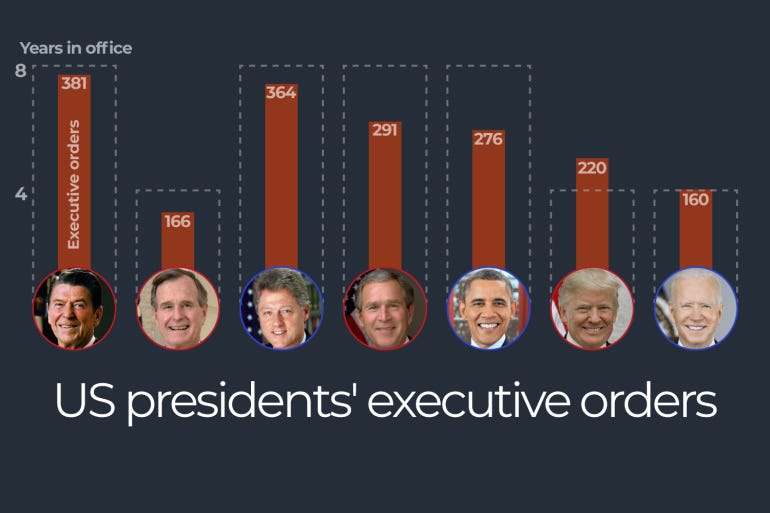How Donald Trump's Executive Orders Compare to Past US Presidents
With a surge in executive orders expected, Al Jazeera examines the history of presidential decrees before Trump's inauguration.
As Donald Trump prepares to be sworn in as the 47th president of the United States on Monday, he is expected to immediately sign a series of executive orders as part of a broader plan, which he shared with Senate Republicans on January 8. These orders, covering topics such as border security, immigration, energy production, and presidential pardons, will shape his early agenda in the White House.
An executive order is a directive issued by the US president to manage federal operations. It carries the force of law but does not require approval from Congress. These orders can address issues within federal institutions and agencies but cannot create new laws. They are also subject to being overturned if deemed unconstitutional, and Congress has the power to override them.
Executive orders are common on a president’s first day in office, helping to set the tone for their administration. The following explores the history of executive orders in the US and what Trump is likely to enact early in his presidency.
History of Executive Orders in the US
Executive orders have been a powerful tool for US presidents to institute policy changes without needing congressional approval. Over 236 years, from 1789 to 2025, 46 US presidents have issued at least 15,902 executive orders, averaging 67 orders annually.
The first executive order was signed by President George Washington in 1789. In the early years of the United States, executive orders were rare, with presidents averaging just a few per term. During the Civil War and Reconstruction (1861-1877), the number of orders increased significantly, particularly under Abraham Lincoln, who issued 48 orders during the war, and Ulysses S. Grant, who issued 217.
The rise of the progressive movement in the late 19th and early 20th centuries saw a marked increase in the use of executive orders. Theodore Roosevelt and Woodrow Wilson, in particular, issued significant numbers, with Roosevelt authoring 1,081 orders and Wilson issuing 1,803 during World War I.
The peak of executive order issuance came under Franklin D. Roosevelt, who signed an astounding 3,721 orders between 1933 and 1945, many in response to the economic challenges of the Great Depression and wartime necessities.
In recent decades, the frequency of executive orders has decreased. Presidents like Barack Obama (276 orders), Donald Trump (220 orders during his first term), and Joe Biden (160 orders) have issued far fewer orders compared to their predecessors.
Key Executive Orders in History
Some of the most influential executive orders in US history include:
Emancipation Proclamation (1863): Issued by Abraham Lincoln, this executive order abolished slavery in Confederate states.
Executive Order 9066 (1942): Signed by Franklin D. Roosevelt, it led to the internment of Japanese Americans during World War II.
Executive Order 9981 (1948): Harry S. Truman’s order desegregated the US military.
Executive Order 10924 (1961): Initiated by John F. Kennedy, this order established the Peace Corps.
Deferred Action for Childhood Arrivals (2012): Under Barack Obama, this order allowed young undocumented immigrants who arrived as children to temporarily stay in the US without fear of deportation.
Executive Order 13769 (2017): Donald Trump’s controversial "Muslim ban," which restricted entry from several predominantly Muslim countries.
Presidents Who Issued the Most Orders
Franklin D. Roosevelt holds the record for the most executive orders, with 3,721 issued during his 12-year presidency. He is followed by Woodrow Wilson (1,803 orders), Calvin Coolidge (1,203), Theodore Roosevelt (1,081), and Harry S. Truman (907).
In comparison, recent presidents like Obama, Trump, and Biden issued fewer orders, with Obama signing 276, Trump issuing 220 during his first term, and Biden currently at 160.
What to Expect from Trump’s Executive Orders
Upon taking office, Trump is expected to sign a broad range of executive orders, many of which will reverse policies enacted by his predecessor, Joe Biden. Among his anticipated actions:
Mass Deportation: Trump is likely to reinstate harsh measures along the US-Mexico border and bring back the controversial travel ban on Muslim-majority countries, continuing policies from his first term.
Energy Policy Rollbacks: He plans to reverse Biden’s climate measures, lifting restrictions on offshore drilling and canceling Biden’s electric vehicle mandates.
Presidential Pardons: Trump has indicated he will issue pardons for those arrested during the January 6 Capitol riot, labeling many of them as “political prisoners.”
With these planned executive actions, Trump is poised to make swift changes upon taking office, echoing the substantial use of executive orders by previous presidents to shape the direction of their administrations.


